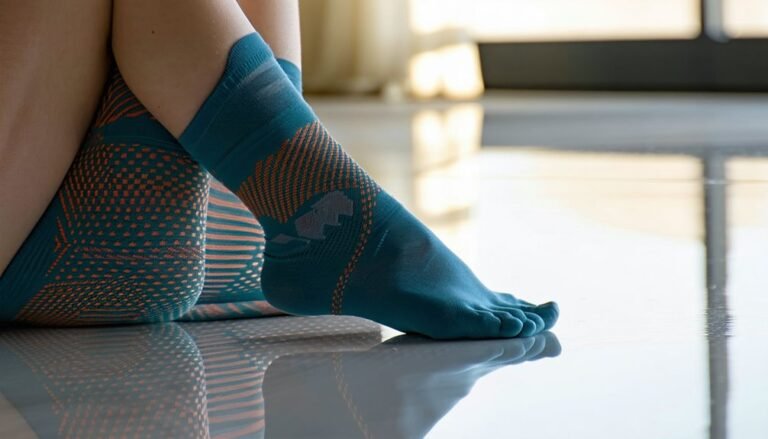Can Compression Socks Raise Blood Pressure?
Compression socks typically don't raise blood pressure; instead, they improve venous return, enhancing circulation that might lower the risk of venous disorders. They apply graduated pressure, most at the ankle, aiding blood flow to the heart. However, individual responses can differ, and it's essential to monitor your blood pressure during use, especially if you have pre-existing conditions. If you explore further, you'll discover tailored guidelines for selecting and wearing compression socks safely.
Understanding How Compression Socks Work

Though often underestimated, understanding how compression socks work is vital for those seeking to manage their blood pressure effectively. Compression socks exert graduated pressure on your legs, with the highest intensity at the ankle, decreasing as it moves upward. This mechanism explanation supports the venous return of blood to the heart, thereby reducing venous pressure and preventing blood pooling in the lower extremities. It's important to recognize the different sock types available: graduated, anti-embolism, and non-medical support hosiery. Graduated compression socks are typically recommended for blood pressure management as they provide precise pressure levels. By selecting the appropriate sock type, you can guarantee ideal safety and efficacy in using compression therapy to support your cardiovascular health responsibly.
The Relationship Between Compression and Blood Pressure
When you wear compression socks, you might experience improved venous return, which can positively influence circulation. This enhancement in blood flow could potentially lead to changes in your blood pressure, although individual responses can vary. It's essential to monitor any alterations in your blood pressure when using compression garments, especially if you have underlying cardiovascular conditions.
Compression Impact on Circulation
While compression socks are often recommended for improving circulation, it's crucial to understand their relationship with blood pressure. Compression socks work by applying graduated pressure to your legs, aiding in circulation improvement and enhancing venous return. This mechanism assists in preventing blood pooling and encouraging efficient blood flow back to the heart, potentially reducing the risk of venous disorders.
| Benefit | Mechanism | Outcome |
|---|---|---|
| Circulation Improvement | Graduated Compression | Enhanced Blood Flow |
| Venous Return | Pressure Gradient | Reduced Blood Pooling |
| Safety Assurance | Consistent Pressure | Lower Venous Disorder Risk |
Wearing compression socks appropriately can support vascular health without adverse effects on blood pressure for most individuals. Always consult your healthcare provider to verify compression socks are suitable for your specific health needs. Safety and efficacy should be your priority.
Potential Blood Pressure Changes
Understanding how compression socks might influence blood pressure is vital for guaranteeing their safe use, especially if you have cardiovascular concerns. Compression therapy works by applying graduated pressure to the lower extremities, which can enhance venous return and reduce edema. However, if the compression is too tight, it could potentially elevate blood pressure by increasing peripheral resistance.
For those with pre-existing blood pressure issues, selecting the right level of compression is significant. Low to moderate compression levels are generally considered safe, but higher compression levels should be used with caution. Always consult a healthcare provider to tailor compression therapy to your specific health needs. This personalized approach guarantees that the benefits of improved circulation are achieved without compromising cardiovascular health or inadvertently affecting blood pressure.
Factors Influencing the Effects of Compression Socks
As you consider using compression socks for managing blood pressure, it is important to recognize the various factors influencing their effectiveness. Material types play an important role, as breathable, moisture-wicking fabrics can enhance comfort, guaranteeing prolonged use without adverse skin reactions. Additionally, compression levels are critical; they must be tailored to your specific needs. Graduated compression, which applies varying pressure along the leg, is often recommended to improve circulation safely.
It is necessary to choose socks with a compression level appropriate for your condition, typically ranging from mild (15-20 mmHg) to firm (20-30 mmHg) pressures. Properly fitted socks can help maintain ideal blood flow, potentially aiding in stabilizing blood pressure. Consulting with a healthcare provider guarantees that you select the most suitable option for your health profile.
Potential Risks and Concerns
When considering the use of compression socks for blood pressure management, it's important to be aware of potential risks and concerns. Compression levels that are too high may impede circulatory health, leading to discomfort or adverse effects. It's vital to monitor for signs like skin irritation or numbness, as these may indicate improper compression. Additionally, individuals with compromised circulation should exercise caution.
| Risk | Cause | Concern Level |
|---|---|---|
| Skin Irritation | High compression levels | Moderate |
| Impaired Circulation | Pre-existing conditions | High |
| Numbness | Prolonged wear | Moderate |
Being informed supports safe use, minimizing negative outcomes. Verify you're selecting the appropriate compression level for your specific circulatory health needs. Consult healthcare providers when in doubt, as they can provide tailored advice on managing blood pressure safely with compression socks.
Guidelines for Safe Use of Compression Socks

While potential risks exist, utilizing compression socks for blood pressure management can be safe and effective if done correctly. First, select appropriate compression levels, typically measured in millimeters of mercury (mmHg). For general purposes, begin with lower levels (15-20 mmHg) and adjust as needed under medical advice. It's essential to verify the socks fit well without being overly tight, as improper fit can lead to circulatory issues.
Pay attention to sock materials; breathable fabrics like cotton or moisture-wicking synthetics can enhance comfort and reduce skin irritation. Regularly inspect your skin underneath for any signs of pressure sores or irritation. By adhering to these guidelines, you can optimize the therapeutic benefits of compression socks while minimizing potential adverse effects.
When to Consult a Healthcare Professional
Why should you consult a healthcare professional when using compression socks for blood pressure management? It's essential to guarantee safety and ideal therapeutic outcomes. You should know when to seek expert advice, especially if you experience symptoms warranting immediate attention. These symptoms include increased swelling, skin discoloration, or persistent discomfort in your legs. Such signs might indicate improper use or adverse reactions to compression therapy.
Additionally, if there's any history of peripheral vascular disease, diabetes, or neuropathy, professional guidance is important before starting or adjusting compression levels. A healthcare professional can tailor recommendations specific to your medical history and condition, guaranteeing that the compression socks support rather than hinder your health goals. Prioritize safety by consulting your healthcare provider to navigate any concerns effectively.
Frequently Asked Questions
Can Wearing Compression Socks Affect My Sleep Quality?
Wearing compression socks might improve sleep comfort by enhancing circulation improvement. They're designed to prevent blood pooling, which can reduce discomfort. If you experience tightness or discomfort, it's essential to adjust fit or consult your healthcare provider.
Are There Alternatives to Compression Socks for Improving Circulation?
Wondering about compression alternatives? Elevate your legs, practice yoga, or try herbal supplements like ginkgo biloba for natural circulation improvement. These methods can enhance blood flow safely, reducing reliance on compression socks while maintaining your circulation health.
How Do I Choose the Right Size of Compression Socks?
To choose the right compression socks, measure your ankle, calf, and leg length. Consult the size chart from the manufacturer, guaranteeing accuracy. Proper sock measurements guarantee effective compression, enhancing circulation while prioritizing your safety and comfort.
Can Compression Socks Be Worn During Exercise?
Oh sure, because who wouldn't want to maximize exercise benefits by improving circulation? Wearing compression socks during exercise can actually enhance performance and reduce fatigue. Just make certain they're the right fit to maintain ideal safety and effectiveness.
Do Compression Socks Have an Expiration or Wear-Out Period?
You're wondering about compression socks' lifespan. Look for expiration signs like loss of elasticity and thinning fabric. Replacement frequency varies, but generally every 3-6 months guarantees peak support and safety, especially if you wear them daily.







